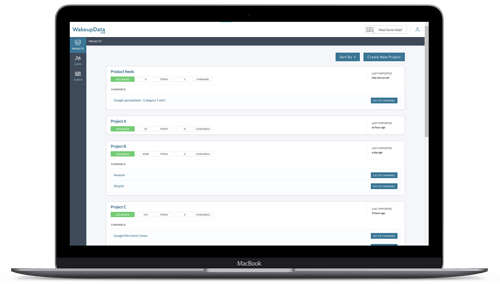Google Shopping Checklist: Do's and Don'ts
Posted on February 23, 2023 (Last Updated: May 29, 2024)
Google Shopping is an incredible platform that has revolutionized the way people shop online. With its extensive reach and user-friendly interface, it has become a go-to destination for shoppers looking to find the best deals and compare products from various retailers. As an online seller, advertising on Google Shopping can significantly boost your sales by putting your products in front of a large customer base actively searching for what you offer.
However, to make the most of this platform, it's crucial to understand and comply with Google's requirements for advertising your products. By doing so, you can ensure that your products are displayed effectively and increase your chances of making a sale.
In this blog post, we will guide you through the do's and don'ts of formatting your product data for Google Shopping. By following these guidelines, you can become a Google Shopping Feed expert and optimize your product listings to attract more customers.
So, let's dive in and explore the key aspects of creating successful Google Shopping ads. We will cover everything from image requirements to titles, descriptions, availability status, pricing, product identifiers, shipping details, and Google product categories. By mastering these essential elements, you can create compelling and informative product listings that stand out from the competition.
Are you ready to take your Google Shopping ads to the next level? Let's get started on your journey to becoming a Google Shopping Feed expert. Read on to discover the tips and strategies that will enhance your product data and drive more sales.
Read on to learn the do’s and don’ts of formatting your product data for Google Shopping.

Image link:
Product images play a crucial role in captivating the attention of potential customers and reinforcing your brand's visual identity. They have the power to enhance engagement and drive conversions in your Google Shopping ads. To maximize the impact of your product images, it's essential to adhere to Google's specific requirements.
By meeting the image size requirements, you ensure that your images are displayed optimally across various devices and platforms. This consistency in image size allows for a seamless browsing experience for users. Additionally, displaying the entire product without any distractions ensures that customers can get a clear view of what they're considering purchasing.
Linking to the main product image is vital as it directs customers to the most relevant visual representation of the product. This helps eliminate any confusion and ensures that shoppers have a consistent experience when navigating from your Google Shopping ads to your landing page.
Using a white background for your product images is highly recommended as it creates a clean and professional look. This allows the products to stand out and be easily visible to potential customers. The contrast between the white background and the product enhances the overall aesthetic appeal and helps draw attention to the key features.
Moreover, uploading high-quality images is essential to showcase your products in the best possible light. High-resolution images provide customers with a detailed view of the product, allowing them to make informed purchasing decisions. Clear and visually appealing images not only attract potential buyers but also instill confidence in the quality of your products.
However, there are certain practices to avoid when it comes to product images. Watermarks, borders, and promotional text should be omitted as they can distract customers and detract from the main focus—the product itself. Overstepping file size limits can negatively impact the loading time of your ads, leading to a poor user experience. It's crucial to optimize image file sizes without compromising quality.
Using URLs that can't be crawled by Google should be avoided, as it hinders the search engine's ability to properly index your images. This can affect the visibility and discoverability of your products. Similarly, using misleading or non-representative images can confuse shoppers and create a negative impression of your brand.
By following these do's and don'ts for product images, you can optimize your Google Shopping ads, increase engagement, and strengthen your brand image. Remember, compelling visuals are a powerful tool in capturing the attention of potential customers and convincing them to choose your products.
Do:- Meet the image size requirements
- Display the entire product without any distractions on the image
- Link to the main product image
- Use a white background to make the products easy to see
- Upload high-quality images
- Include watermarks, borders or promotional text
- Overstep file size limits (e.g. 64 megapixels or 16 MB)
- Use URLs that can’t be crawled by Google
- Use images that aren’t representative of the product and can mislead shoppers
Title:
Choosing the right title is crucial because it’s one of the first things customers see when they’re searching for new products. The information in your titles is also part of what allows Google to match your products with the right searches.
Do:- Use relevant keywords
- Make sure titles are 70 characters or less
- Write descriptive titles using clear and concise language
- Mention brand, colour, size/material and product type
- Forget to be consistent with your product titles – make sure that your landing page and Google Shopping titles match
- Use abbreviations
- Make false or misleading claims in your product titles
Pro tip: Use clever rules to automatically check if brand and/or attributes are missing from your titles. If they are, the same automation can insert them without adding extra work for you. In WakeupData, this can be done with Field Conversions.
Description:
A great description can help you stand out from your competitors and generate sales by convincing your customers that your products are worth purchasing. Great descriptions aren’t just good for advertising – they’re an absolute must for good SEO results.
Do:- Be sharp when writing your descriptions, describe your products in a way that benefits users and will encourage them to buy
- Match your description with your landing page
- Only include information that’s accurate and up to date
- Highlight key features (e.g. durability, design, comfort) that set your product apart from others
- Only write about your products, don’t talk about the company, etc.
- Include links in your description
- Forget to include important details (e.g. size, shape, pattern, texture, design, material, intended age range, special features, technical specs)
- Copy and paste from other sources such as the manufacturer’s website
- Write descriptions that are too short (the limit is 1 - 5 000 characters)
Availability:
Stating the availability status is important to show shoppers that they can actually purchase the product. This will also give them an idea of when to expect delivery.
Do:- Submit an accurate product availability status
- Make sure to match your Google Shopping products’ availability with your landing page
- Use values accepted by Google such as ‘in_stock’, ‘out_of_stock’, ‘preorder’
- Consider using a ‘back-in-stock’ notification system to let customers know when a product they’re interested in is available again
- Forget to include an estimated availability date
- Advertise products as preorder that are not brand new, and don’t forget to add the availability date
- Use vague language such as ‘usually/sometimes in stock,’ which can confuse shoppers
Price:
Price is an important factor for online shoppers, who often choose products based solely on price.
Do:- Submit accurate price information
- Ensure that the product price is shown in the local currency of the target country
- Keep your prices up to date
- Be transparent by informing customers of any additional costs
- Include VAT (i.e. value added tax)
- Forget to match the price with the landing and check-out pages
- Set ‘0’ as the price
- Make misleading claims about your prices
Pro tip: Here is our blog on how to fix price mismatch in Google Merchant Center
Product Identifiers (brand, GTIN, MPN, Identifier exists):
Unique product identifiers help identify your products in the global marketplaces.
Do:- Add GTIN (Global Trade Item Number)/EAN (European Article Number) numbers, which can increase conversion rates and simplify warehousing
- Regularly update identifiers
- Remember to include the brand name because it creates consistency and can help increase brand loyalty
- Provide the correct brand to ensure a good user experience
- Use MPN for all products without a manufacturer-assigned GTIN
- Fill in this field if the product doesn’t have a specific brand (e.g. label is missing from a piece of clothing)
- Use the same identifier for multiple products
- Submit values like ‘does not exist’ or ‘no brand’
- Submit a GTIN if you’re not sure that it’s correct
- Don’t use a MPN value that you created yourself
Shipping:
Shipping costs and speeds are good differentiators, especially in Europe.
Do:- Provide accurate shipping costs - rather overestimate than underestimate if you don’t know the exact price
- Add the shipping country - it is required (ISO country code)
- Include information about shipping speeds and locations
- If possible, provide tracking information to ensure that customers can see where their products are and when they’ll be delivered
- Forget to add the different shipping services that are available (e.g. home delivery, parcel pickup) although it is not mandatory, it can help the shoppers’ purchasing journey
- Wait too long to update shipping status – this can lead to a negative customer experience and Google can flag discrepancies between the webshop availability and the feed
Pro tip: WakeupData can prevent that by using hourly updates - Fail to include the shipping companies’ name – many customers have preferences
Google product category:
Showing Google product category to your customers is a crucial step in ensuring that your products are correctly categorized and easily distinguishable from others. This not only helps Google generate automatically generated product categories accurately but also enhances the visibility and discoverability of your products.
To optimize your product listings, it is essential to provide high-quality, on-topic titles and descriptions, accurate pricing, brand, and GTIN information. By doing so, you enable Google to accurately categorize your products and match them with relevant search queries.
Including the appropriate category that best suits your product is vital. It helps potential customers find your products more easily when they are searching for specific items. Be as specific as possible in selecting the category that closely aligns with your product.
Follow Google's recommendation to use the full path of the category over the numerical category. This ensures that your products are placed in the most relevant and accurate category, increasing the chances of attracting the right audience.
It is important to use only predefined Google product categories. Creating your own categories that are not part of the Google taxonomy can lead to confusion and misplacement of your products, decreasing their visibility.
While using subcategories can provide more specific details about your products, it is essential not to use too many subcategories. This can overwhelm and confuse shoppers, making it difficult for them to find what they are looking for. Use subcategories judiciously when they add value to the understanding of your products.
By effectively utilizing Google product categories, you can ensure that your products are accurately classified and easily discoverable by potential customers. This, in turn, increases the visibility and chances of attracting the right audience to your product listings. So, make sure to provide accurate and relevant information to optimize your Google Shopping ads and drive more sales.
Do:- Include the category that best suits your product
- Be as specific as possible
- Follow Google’s recommendation to use the full path of the category over the numerical category
- Use only predefined Google product categories
- Use subcategories when it's appropriate to provide more specific details about your products
- Include more than one category
- Create your own product categories that are not part of the Google taxonomy
- Use incorrect and misleading categories to increase product visibility
- Use too many subcategories, which can confuse shoppers
Pro tip: You can use WakeupData Actions to add Google categories/taxonomy to your feed. This ensures that the categories match the right shopper search queries, leading to the maximal number of impressions and clicks from your Google ads.
Summary
As you would have guessed by now, sending the correct and up-to-date information to Google is absolutely key to be competitive.
By following the guidelines above, you can ensure that you’re providing sufficient data to Google and that your ads have the best chance of being shown and converted to sales. We know that this can be a time-consuming task, but fear not, we are here to help you all the way!
Ensuring that your product information is accurate and up-to-date is crucial not only for your competitiveness but also for building trust with your customers. When customers see that you have taken the time to provide accurate details about your products, it instills confidence in them and increases the likelihood of making a purchase.
In addition, providing accurate information to Google helps improve the visibility of your products in search results. When your products are accurately categorized and have all the relevant details, they are more likely to be shown to potential customers who are actively searching for similar products.
By taking the time to carefully craft your titles, descriptions, and other product information, you are not only helping Google but also helping yourself. Clear and concise titles that include important details like brand, color, size/material, and product type help customers quickly understand what your product is all about. Descriptive and compelling descriptions that highlight key features and benefits will convince customers that your product is worth purchasing.
Remember, consistency is key. Make sure that your product titles on your landing page and Google Shopping match. This ensures a seamless experience for customers and avoids confusion.
In summary, providing accurate and up-to-date information to Google is essential for staying competitive in the online marketplace. By following the guidelines and best practices mentioned above, you can optimize your product listings, increase visibility, and ultimately drive more sales. And if you ever need assistance along the way, our team is here to support you every step of the way.
To learn more about optimising and managing your product data and product feeds, book a demo with one of our feed experts and see how we can help you get started.



